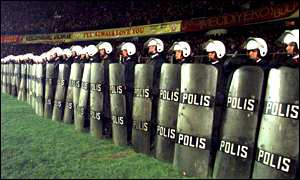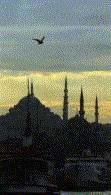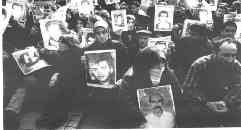Istanbul . Fatih . Eminou . Beyoglu . Besiktas . Sariyer . Trakya
Back to Guide Main

 Istanbul is huge – there is simply no other way to describe it. In the
past ten years the city has almost doubled in size due to economic migration
from the Black Sea region and Kurdish refugees driven out of their villages in
the Southeast. Depending on how you want to count it, the population can be
estimated at up to fifteen million. The population has grown so fast that no
telephone books have been published there since 1992.
Istanbul is huge – there is simply no other way to describe it. In the
past ten years the city has almost doubled in size due to economic migration
from the Black Sea region and Kurdish refugees driven out of their villages in
the Southeast. Depending on how you want to count it, the population can be
estimated at up to fifteen million. The population has grown so fast that no
telephone books have been published there since 1992.
 in front of Galatasaray Lisesi at noon. Every week for the past three years
these old women (most of them Kurds) have been coming to demonstrate regarding
their children who have disappeared, presumably taken and killed by the
security forces. This demonstration has been attacked several times over the
years, and there are always several hundreds of sinister-looking Steel Force
riot police ranked up in phalanxes in full Star Wars riot gear complete with
automatic weapons and attack dogs. Back on Meshurrieyet Cad. police buses wait
to take away the prisoners. In a cynical effort to mislead the media, an
Interior Ministry van which reads "Missing Persons Search Assistance"
is always parked, unused next to the Lise.
in front of Galatasaray Lisesi at noon. Every week for the past three years
these old women (most of them Kurds) have been coming to demonstrate regarding
their children who have disappeared, presumably taken and killed by the
security forces. This demonstration has been attacked several times over the
years, and there are always several hundreds of sinister-looking Steel Force
riot police ranked up in phalanxes in full Star Wars riot gear complete with
automatic weapons and attack dogs. Back on Meshurrieyet Cad. police buses wait
to take away the prisoners. In a cynical effort to mislead the media, an
Interior Ministry van which reads "Missing Persons Search Assistance"
is always parked, unused next to the Lise.
Only about 5% of Turkey lies on the European continent, much of this area beng taken up by Istanbu's srawling Western suburbs. Strangely, even though rural Trakya is so close to Istanbul, it ahs some areas of surpising natural beauty; unspoilt beaches, green forests, quiet lakes and forgotten ruins in addition to the shithole concrete towns and tangled mess of motorways.
Trakya is also where the frontiers with Greece and Bulgaria are, and if you are crossing through to or from these countries you will have to pass through Trakya.
Edirne is a frontier city only a few kilometers from Bulgaria and Greece. This was not always the case (Edirne was once the capital of the Ottoman Empire) but politics have a funny way of influencing geography. While Edirne has an excellent assortment of Ottoman mosques, bedestens and so on, it is really just a very large truck stop sitting as it does on the main land communications route to Europe.
Getting to Bulgaria from Edirne is simple. The cheapest route is simply to take a dolmus from the centre to Kapikule and then just walk into Bulgaria. On the Bulgarian side there are taxis to Svilingrad where you can get a train or a bus to points West and North. From the otogar in Edirne you can get a bus to Sofia, Burgas or Plovdiv and two trains a day go to Bulgaria (one to Sofia and one to Velinko Tarnovo), but this method is slower and more expensive than just doing it yourself.
Getting to Greece is another story. Due to the perpetual hostile diplomatic relations between Turkey and Greece, walking across is not permitted. The frontier is heavily fortified and most likely heavily mined. A night train leaves from Sirkeci station in Istanbul on to Salonika in Greece passing through Edirne in the early hours of the morning. Busses leave from various places in Istanbul like Aksaray, but there are not as many of them as you might expect. Coming the other way from Greece is much more difficult. Your best bet may just be to show up at the crossing and hitch.
Kiyikoy is an old walled Black Sea town about three hours journey west from Istanbul, but it might seem more like thirty as isolated and uncorrupted as this place is. Kiyikoy has the advantage of being at the end of some bad roads and there is no road along the coast for some sixty kilometres in this part of the Black Sea. This means the beaches on both sides of Kiyikoy are imaculate, unspoilt and empty. Camping on the beach or in the forests behind the beach is a simple process of walking until you find an appropriate spot.
The town itself has a village atmosphere with flocks of sheep being herded through the street and tractors parked in front of shops. There are some cheap restaurants and tea houses here and some nice, but over priced pansiyons (about $15 a night). It is very calm and quiet. Kiyikoy has yet to be hit with the sort of swarming concrete development which has devastated the Aegean and Mediterranean areas.
To get to Kiyikoy by bus you need first to get a bus from the Bayrampasa otogar in Istanbul to Cerkezkoy or Saray. From Saray Kiyikoy Belediye busses leave hourly for Kiyikoy, but they stope running around dark. Hitching from Saray is very easy once you find the right road.
The Sea of Marmara has an ancient history, but it's modern function is primarily to be the cesspool for Istanbul, Izmit and Bursa. More than twenty million people live around this small inland sea and two thirds of Turkey's industry is here. So don't eat the fish, even though they all say its from the Black Sea.
That said, there are some good places here which you should visit. The Marmara islands are beautiful, seldom visited by foreigners and cheap. Bursa and Canakkale are easer to get to than the islands and offer some interesting distractions.
All the English speaking Turks speak with a broad Australian accent here which can be very disconcerting. The reason is that across the Straites are the Galipoli battlefields and it is a major pilgrimige site for Autralian and New Zealand tourists. But don't let this get you down: Canakkale is also the gateway to the North Aegean region.
The town itself is on the East side of the Dardanelles a bit down from the Narrows. It has been a major strategic place for thousands of years and evidence of fortifications from dozens of civilisations litter the area including the disappointing ruins of Troy. Most of the accomodation is near the clocktower about two blocks from the ferry landing. If you go back from there, cheap eateries abound in the market area. A good cheap place to stay is the Kervansaray where beds can be found for around $3 a night.
South from Canakkale are some of the most impressive olive growing regions in Turkey and the coast here is not all that spoilt yet. You can take a local bus to Geyikli which is a nice little Aegean town with a pleasant square and street cafes, and from there hitch farther in. Close to Geyikli is Odun Iskelisi where ferries leave three times a day for the lovely vinyard covered island of Bozcaadi. Bozcaada is a good place to camp on the beach and get blind on the local wine, but there is little cover on the island and you are likely to fry in the sun.